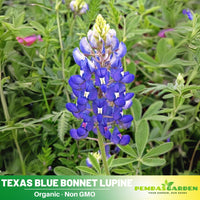Texas Blue Bonnet Lupine - Authentic Seeds - Perennial ~ GMO Free~~Flower seeds ~ Asian Garden~ Herbs #8101 Sale
- $3.79
-
Regular price
$7.50
Step-by-Step Guide
1. Seed Preparation
Scarification: Texas Bluebonnet seeds have a hard seed coat that benefits from scarification to improve germination rates. Gently nick the seed coat with a file or sandpaper, or soak the seeds in warm water for 24 hours to soften them.
2. Sowing Seeds
Outdoor Sowing
Timing: Sow seeds directly outdoors in the fall. Texas Bluebonnets are adapted to germinate in cooler temperatures and grow through the winter, blooming in spring.
Location: Choose a sunny spot with well-draining soil. Texas Bluebonnets thrive in full sun and prefer sandy or gravelly soils that drain well.
Planting Depth: Scatter the seeds on the soil surface and cover lightly with soil, about 1/4 inch deep. Press them gently to ensure good seed-to-soil contact.
Watering: Water the seeds gently to keep the soil moist until they germinate. Avoid overwatering, as Bluebonnets are adapted to drier conditions.
Indoor Sowing
While Texas Bluebonnets are typically sown directly outdoors, you can start them indoors if you prefer:
Timing: Start seeds indoors 6-8 weeks before the last expected frost. This gives the seedlings a head start before transplanting outdoors.
Containers: Use deep seed trays or pots with drainage holes. Bluebonnets develop a deep taproot, so deeper containers are beneficial.
Soil: Use a well-draining seed starting mix. Bluebonnets prefer a mix that mimics their natural habitat.
Planting Depth: Sow the seeds about 1/4 inch deep.
Watering: Moisten the soil with a spray bottle to keep it consistently moist but not waterlogged.
3. Germination Conditions
Temperature: Maintain a soil temperature of 55-65°F (13-18°C) for optimal germination. Texas Bluebonnets prefer cooler soil temperatures for germination.
Light: Provide bright, indirect light if starting indoors. Place indoor seed trays near a sunny window or under grow lights for at least 6-8 hours a day.
Moisture: Keep the soil consistently moist but not waterlogged. Mist the soil surface with water if it starts to dry out.
4. Germination Time
Expect germination in about 10-14 days under optimal conditions.
5. Seedling Care
Thinning: Once the seedlings are a few inches tall and have developed their first true leaves, thin them out to prevent overcrowding. Space them about 12 inches apart to ensure they have room to grow and good air circulation.
Light: Ensure seedlings receive plenty of light. If growing indoors, place them in a sunny window or under grow lights for at least 6-8 hours a day.
Watering: Continue to keep the soil moist but not soggy. Water gently to avoid displacing the seedlings.
6. Transplanting
Hardening Off
Timing: Begin hardening off seedlings about a week before transplanting them outdoors. This helps them acclimate to the outdoor environment and reduces transplant shock.
Method: Gradually expose the seedlings to outdoor conditions, starting with a few hours of sunlight per day and increasing the duration over several days.
Outdoor Planting
Timing: Transplant seedlings outdoors after the last frost date and when they are sturdy enough to handle. Ideally, transplant in early spring.
Location: Choose a sunny spot with well-draining soil. Texas Bluebonnets thrive in full sun and prefer sandy or gravelly soils.
Spacing: Space the plants about 12 inches apart to allow for growth and airflow. This helps prevent disease and promotes healthy growth.
7. Ongoing Care
Watering: Water regularly to keep the soil moist, especially during dry spells. Texas Bluebonnets prefer consistent moisture during their growing season but are drought-tolerant once established.
Mulching: Apply a thin layer of mulch around the plants to help retain moisture and suppress weeds. This also helps maintain an even soil temperature.
Fertilizing: Texas Bluebonnets do not require much fertilization. Avoid over-fertilizing, as too much nitrogen can lead to excessive foliage growth at the expense of flowers.
Pruning: Deadhead spent flowers to encourage continuous blooming and prevent the plant from putting energy into seed production. Cut back the plants after flowering to promote new growth.
8. Pest and Disease Management
Monitoring: Watch for common pests such as aphids and slugs. If necessary, treat with insecticidal soap or neem oil.
Disease Prevention: Texas Bluebonnets are relatively disease-resistant but can be susceptible to root rot if the soil is too wet. Ensure good air circulation around the plants and avoid overhead watering to reduce the risk of fungal diseases.
Treatment: If disease occurs, remove and dispose of affected leaves immediately. Apply a fungicide if necessary and ensure proper spacing and air circulation.
Summary of Growing Duration
From Sowing to Germination: Approximately 10-14 days.
From Planting to Flowering: Texas Bluebonnets typically bloom in late spring, with flowers lasting several weeks.
Additional Tips
Soil Preference: Texas Bluebonnets thrive in well-drained, sandy, or gravelly soil. They prefer slightly acidic to neutral pH.
Sunlight: Provide full sun for the best growth and flowering. Texas Bluebonnets need at least 6-8 hours of sunlight per day.
Drought Tolerance: Once established, Texas Bluebonnets are relatively drought-tolerant and can thrive in dry conditions.
Self-Seeding: Texas Bluebonnets often self-seed and can return year after year if conditions are favorable. Allow some of the plants to set seed and drop naturally to encourage reseeding.
SHIPPING
?Flat Rate delivery no matter how many seeds you order;
? Growing instructions included on each seed packet;
? FREE SHIPPING on all orders of $30 or more
.
? Please note that we cannot guarantee the success of seeds or plants because these aspects
depend on the environment in which they are cultivated.
Related product



